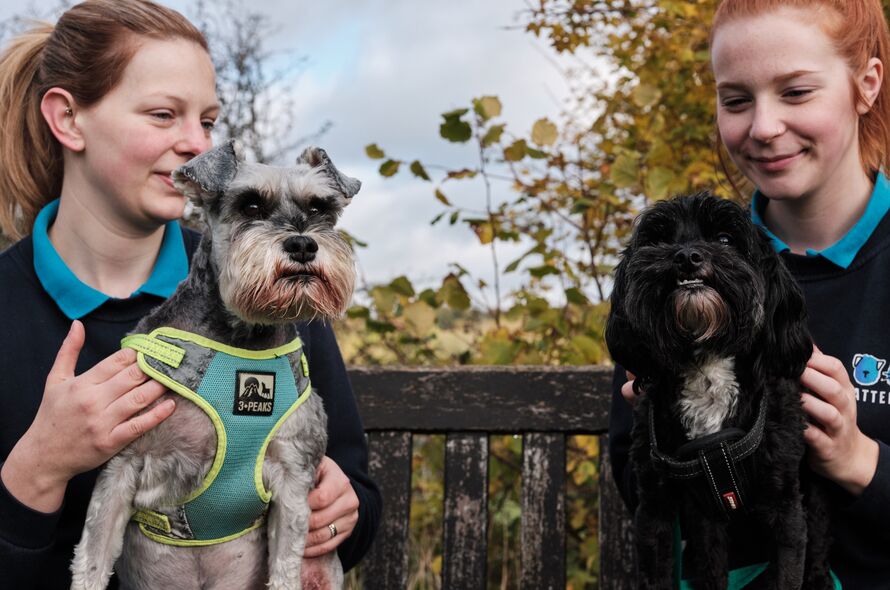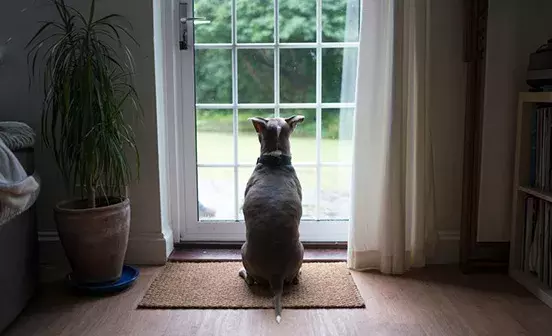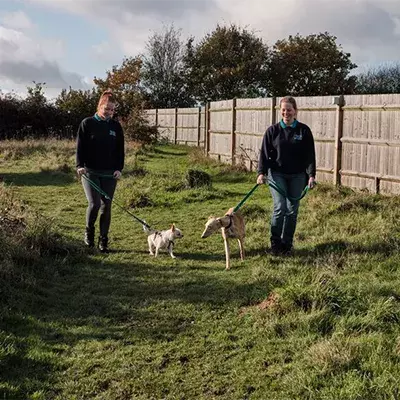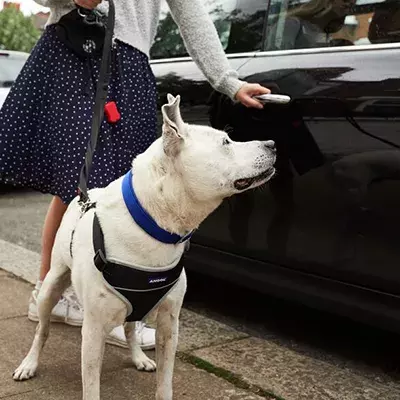When we get a new dog, we all want them to get on well with our other family pets and immediately feel like members of the family. It is important however, to take the time to carefully plan and manage the first meetings between new and existing dogs, and to make sure that each animal is given plenty of time and space apart during the settling process. By planning in advance, you are much more likely to be able to build successful relationships in a household with multiple dogs.

If you’re not familiar with the different social cues and body language that dogs use to communicate with us and each other, we would recommend taking a look at our advice on dog body language to help you read different situations and better understand what your dogs are feeling.
What to do before bringing your new dog home
Before your new dog comes home, set up the environment in a way that gives both dogs the best chance of getting used to each other on their own terms.
Food
Where will the new dog eat? Where does your current dog eat? Feeding dogs in the same area can put unnecessary pressure on them which can lead to squabbles. Prevention is always better than cure, so where possible, feed each dog in a separate room and have a few water bowls dotted around the house. Be sure to separate the dogs when giving any chews and bones, as these are prized items that dogs are more likely to guard from each other.
Bed
Settling into a brand-new environment can be very stressful for a dog. Think about safe spaces for each of your dogs; places that they can retreat to when they want a little “time out” from one another. Not all dogs will want to cuddle up together to sleep, or even be in close proximity to another dog when sleeping. Dogs are at their most vulnerable when they’re asleep, so bear this in mind when thinking of what type of bed to get your new dog and where to place it in relation to your existing dog’s bed. If your new dog is used to a certain type of bed, like a covered crate, soft bed, hard bed, mattress etc it might be that providing them with a similar kind of bed could help them feel more comfortable.
Toys
Some dogs love them, and some dogs aren’t particularly bothered by them. It may be fine leaving dog toys lying around with only one resident dog, but a lack of supervision around toys could lead to squabbles in a household with more than one dog. Think about getting sealable boxes for your different dogs’ toys and where you would place these in different places to prevent issues.
Time alone
Whilst it is important for social dogs to spend time together, they will also need some one-on-one time with you and will need to practice some time apart. Your new dog will need to build a bond with you to feel safe and secure, and your existing dog will still need love and attention to feel secure despite the change in household dynamics. This is especially true when a puppy or juvenile dog comes home to live with an adult dog. The younger dog will need a lot of training and input to develop into a well-rounded dog, and the adult dog will need some breathing space so they’re not being pestered to play 24/7.
Using baby gates in the home can be a great help with this, as they act as a physical barrier but not a visual one. Consider where you could utilise them in the home and be sure to have them set up before bringing the new addition home. You should always supervise dogs when separating them with a baby gate to ensure neither attempt to jump over it or bother the other dog through it. Once your new dog is home you can spend some time playing with or training one dog while the other is on the other side of the gate kept occupied with a Kong or chew. This still counts as socialisation for the dogs, with each dog learning to relax around one another in a low-pressure setting.
Taking your new dog home
Wherever possible it’s a good idea to carry out at least one dog-to-dog introduction before you bring a new puppy or dog home, but meeting in a neutral place is different to sharing a home together. Remember that both dogs will need time to build a bond in order to feel comfortable around each other, but if you have taken the time to prepare for your new arrival and followed the advice above, you have already set them up with the best chance for success.
Plan your journey home with your new dog
- Will you have your resident dog with you?
- If so, you will probably need an extra pair of hands to help with the journey home.
- Are you planning to take public transport home, or are you bringing your own vehicle/taking a pet-friendly taxi?
- We do not recommend both dogs travelling in the boot of your own vehicle, on the back seats or in the same crate unsupervised, so consider how you will keep both dogs safe, secure and separated for the duration of the journey.
When you arrive home with your new dog
Take them for a walk
When you first get home with your new dog, don’t go indoors straight away. Instead, take both of your dogs for a walk together in an area with lots of open space where they can take their time to explore and get to know one another in their own time on more neutral ground. You may have to arrange for a friend or family member to help you by walking one of the dogs so you can give them as much space as they need to be able to relax.
It’s natural to be excited but try and be as casual as possible and allow them to interact in their own time. Don’t force them towards each other and don’t pick up either dog or try to push them to say hello as this could create tension between them. Instead, praise any positive behaviours and let things happen in their own time. Bear in mind if you have had a particularly long or stressful journey home, your new dog might need a while to calm down on this walk before they’re in the right mood to calmly and successfully greet your resident dog.
Make sure the house is in order
Before bringing your new dog into the house, make sure any food and toys are out of reach and there are multiple water bowls and beds spread throughout the home to prevent any possible friction between the dogs. It may be a good idea to keep both dogs on lead or have their leads attached and trailing indoors for a short while just in case you need to calmly move them away from one another and give them some space.
Watch for signs of stress and try to minimise it
It’s important to monitor your dogs carefully and read for signs in their body language that indicate they could do with a little break apart. Keep the first two-three weeks as calm as possible and try and avoid having lots of visitors come over to say hello to your new dog. The first few weeks are crucial in establishing routine and stability in the home, so the fewer external factors you have to deal with in these early stages, the better. Once your dogs are more comfortable with each other and have both adjusted to the new routine and changes in environment then they will be much more comfortable with other people and busier situations.
If you experience problems introducing your dogs, don’t persist with introducing them as this could damage the relationship completely. Instead, we would recommend getting in touch with a qualified behaviourist, or the Battersea advice line for more help and information.



